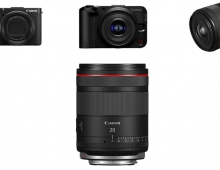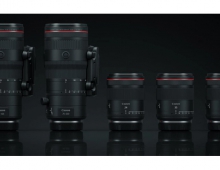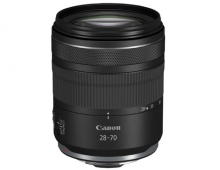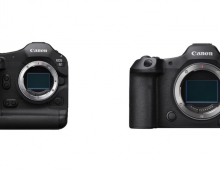
Canon Named 'America's Choice' For Digital Cameras in 2004
America has spoken, and it has chosen Canon as the leading brand for digital cameras in 2004, according to recently released retail sales data from The NPD Group, one of the leading providers of retail market information.
The NPD Group reports that the Canon brand captured the number one position in Total Digital Camera Sales in 2004, with a market share of 20.4 percent, based on unit sales of both compact cameras and digital SLR cameras combined*. In addition, Canon was the number one brand in both NPD's Digital Point-and-Shoot and Digital SLR categories, with market shares of 18.6 percent and 62.8 percent, respectively.
"The NPD data, which we believe is a true, accurate indicator of real market activity, shows that when it comes to meeting their digital imaging needs, customers are choosing Canon over any other brand on the market," said Yukiaki Hashimoto, senior vice president and general manager of the consumer imaging group, Canon U.S.A., Inc. "From the first-time, entry-level user to the most sophisticated shutterbug, Canon delivers the superior imaging technology, innovative features and stylish designs that fit America's diverse lifestyles."
More and more customers have come to recognize the high quality and reliability that has been designed into Canon's entire line of digital cameras, from its highly-acclaimed PowerShot(R) cameras to its award-winning Digital Rebel(R). In fact, more consumers purchased the Canon PowerShot A75 digital camera in 2004 than any other single digital camera on the market, while the EOS Digital Rebel was 2004's top seller in the digital SLR category, according to NPD data.
The digital camera category is clearly one of the best selling hardware segments in the photographic industry, and it is also one of the most competitive. In the U.S. market, more than 13 million compact digital cameras (non-SLRs) and nearly 600,000 digital SLRs were sold in 2004, according to NPD. In the digital camera category, Canon has consistently turned in strong performances, thus enabling the company to expand its market share.
A Brief History of Canon's Progress in the Digital Camera Market
Canon's success in the digital camera market was not built overnight. The company's first internally developed model, the PowerShot 600, was announced in 1996 and originally marketed as a computer peripheral through a subsidiary company. When it became apparent that the future of digital cameras was going to be in the consumer market, Canon reorganized itself from the top down and assigned responsibility for design, development, manufacturing and marketing to the Camera Division, which had a long history of success in traditional 35mm cameras. When the PowerShot S100 Digital ELPH and EOS D30 Digital SLR models appeared in 2000, their unique and innovative features catapulted Canon into the spotlight of media publicity and popularity with consumers. At that point, it was clear that Canon was on its way to the kind of success it had come to expect after nearly 25 years of market leadership in the traditional camera industry.
Advertising taglines such as "Are You Digital Yet?" sparked popular interest in the Canon brand. Each year, Canon gained market share and became more popular with consumers. As the digital camera market grew, so did the success of Canon's revolutionary products and technologies.
To support its success, Canon designs, develops and manufactures its own lenses, image sensors, image processors and color rendering software. With consistently high annual investments in research and development, Canon continues to stay ahead of the market with its innovative imaging technologies, such as UA (Ultra High Refractive Index Aspherical) Lens Technology, the DIGIC(R) (Digital Imaging Integrated Circuit) and DIGIC(R) II image processors, as well as Canon CMOS image sensors for the company's EOS Digital SLR cameras.
Canon, which is also one of the top holders of technology patents in the U.S., has created a unique synergy between its research and development team and its product groups that allows it to consistently introduce high quality and reliable imaging products for every level of user. In fact, the editors of PC Magazine recently honored Canon's digital cameras with the highest rankings in quality, reliability and support in their annual reader satisfaction survey.
In addition to its recognition by PC Magazine readers, Canon digital cameras have been honored by PC World, American Photo, C/NET, Macworld, Mobile PC Magazine, Best Magazine, Popular Science, Outside Magazine and PTN Magazine, among others, in 2004.
For more information on the history of Canon cameras, please visit www.canon.com/camera-museum/
* According to The NPD Group, Canon has held the number one position in digital cameras throughout 2004, based on unit sales and revenue figures compiled from consumer information and point-of-sale data collected from retailers and other distribution channels. Data made available January 26, 2005.
"The NPD data, which we believe is a true, accurate indicator of real market activity, shows that when it comes to meeting their digital imaging needs, customers are choosing Canon over any other brand on the market," said Yukiaki Hashimoto, senior vice president and general manager of the consumer imaging group, Canon U.S.A., Inc. "From the first-time, entry-level user to the most sophisticated shutterbug, Canon delivers the superior imaging technology, innovative features and stylish designs that fit America's diverse lifestyles."
More and more customers have come to recognize the high quality and reliability that has been designed into Canon's entire line of digital cameras, from its highly-acclaimed PowerShot(R) cameras to its award-winning Digital Rebel(R). In fact, more consumers purchased the Canon PowerShot A75 digital camera in 2004 than any other single digital camera on the market, while the EOS Digital Rebel was 2004's top seller in the digital SLR category, according to NPD data.
The digital camera category is clearly one of the best selling hardware segments in the photographic industry, and it is also one of the most competitive. In the U.S. market, more than 13 million compact digital cameras (non-SLRs) and nearly 600,000 digital SLRs were sold in 2004, according to NPD. In the digital camera category, Canon has consistently turned in strong performances, thus enabling the company to expand its market share.
A Brief History of Canon's Progress in the Digital Camera Market
Canon's success in the digital camera market was not built overnight. The company's first internally developed model, the PowerShot 600, was announced in 1996 and originally marketed as a computer peripheral through a subsidiary company. When it became apparent that the future of digital cameras was going to be in the consumer market, Canon reorganized itself from the top down and assigned responsibility for design, development, manufacturing and marketing to the Camera Division, which had a long history of success in traditional 35mm cameras. When the PowerShot S100 Digital ELPH and EOS D30 Digital SLR models appeared in 2000, their unique and innovative features catapulted Canon into the spotlight of media publicity and popularity with consumers. At that point, it was clear that Canon was on its way to the kind of success it had come to expect after nearly 25 years of market leadership in the traditional camera industry.
Advertising taglines such as "Are You Digital Yet?" sparked popular interest in the Canon brand. Each year, Canon gained market share and became more popular with consumers. As the digital camera market grew, so did the success of Canon's revolutionary products and technologies.
To support its success, Canon designs, develops and manufactures its own lenses, image sensors, image processors and color rendering software. With consistently high annual investments in research and development, Canon continues to stay ahead of the market with its innovative imaging technologies, such as UA (Ultra High Refractive Index Aspherical) Lens Technology, the DIGIC(R) (Digital Imaging Integrated Circuit) and DIGIC(R) II image processors, as well as Canon CMOS image sensors for the company's EOS Digital SLR cameras.
Canon, which is also one of the top holders of technology patents in the U.S., has created a unique synergy between its research and development team and its product groups that allows it to consistently introduce high quality and reliable imaging products for every level of user. In fact, the editors of PC Magazine recently honored Canon's digital cameras with the highest rankings in quality, reliability and support in their annual reader satisfaction survey.
In addition to its recognition by PC Magazine readers, Canon digital cameras have been honored by PC World, American Photo, C/NET, Macworld, Mobile PC Magazine, Best Magazine, Popular Science, Outside Magazine and PTN Magazine, among others, in 2004.
For more information on the history of Canon cameras, please visit www.canon.com/camera-museum/
* According to The NPD Group, Canon has held the number one position in digital cameras throughout 2004, based on unit sales and revenue figures compiled from consumer information and point-of-sale data collected from retailers and other distribution channels. Data made available January 26, 2005.





















